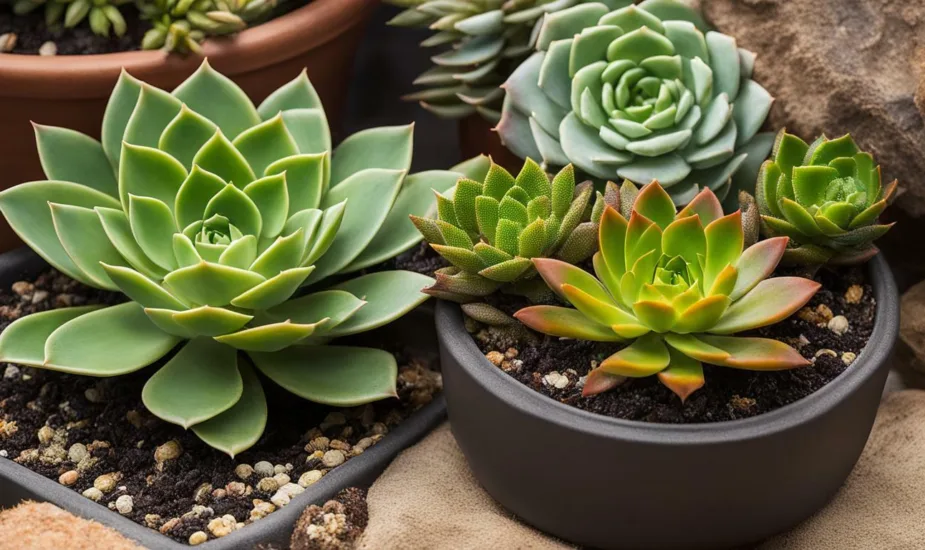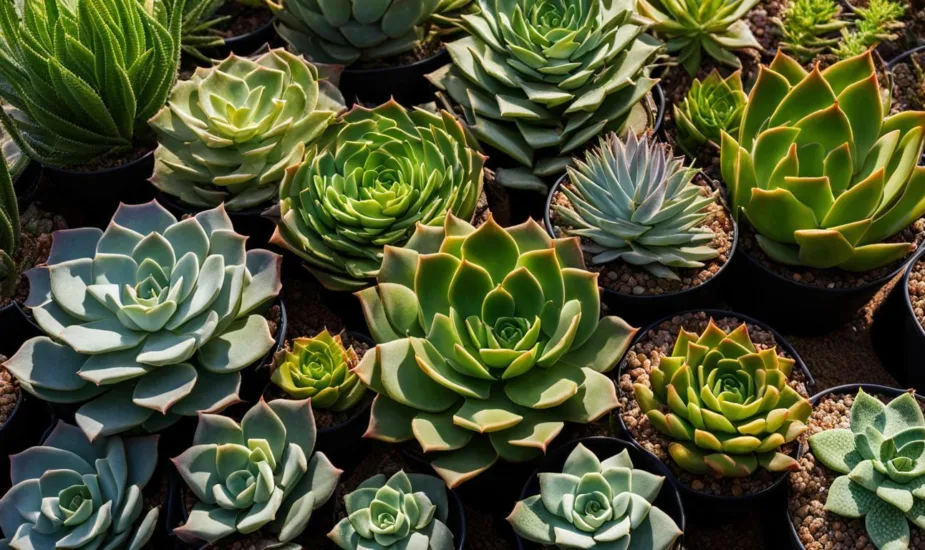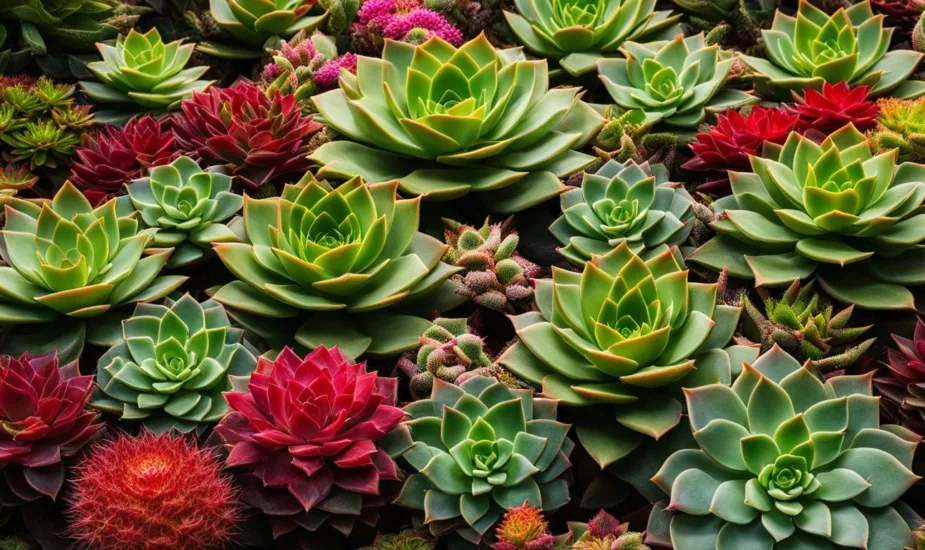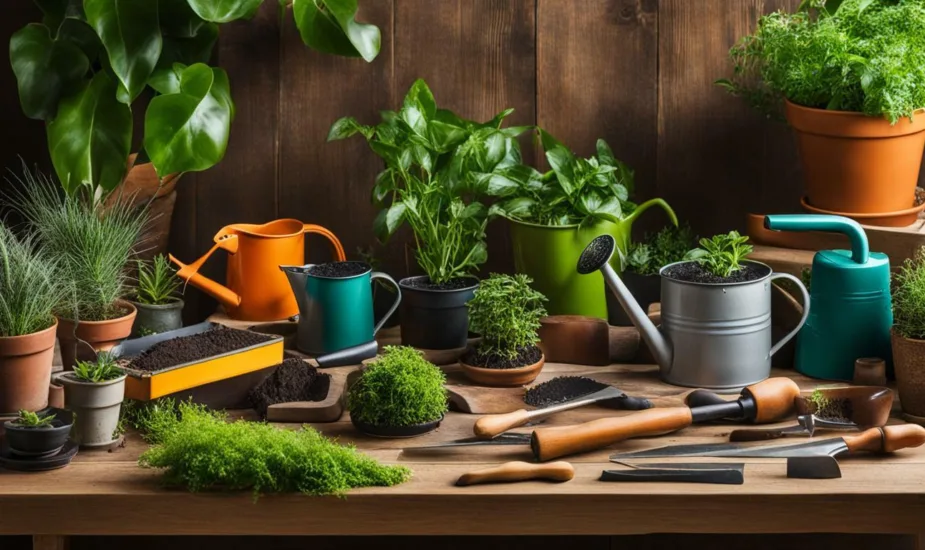Growing Morning Glory in Pots: Easy Care Guide for Beginners
As an avid gardener, I believe that container gardening is a fantastic way to cultivate beautiful, vibrant plants in limited space, and one of my favorite plants to grow in pots is morning glory.

A Morning Glory is so popular because not only are they easy to grow, but they also produce stunning, trumpet-shaped flowers in a range of eye-catching colors, from soft pastels to bold purples and blues. In this article, I’ll share my tips and insights on how to grow morning glory in pots successfully, from choosing the right containers and soil to providing the right support and care.
Key Takeaways:
- Morning glory is a versatile and rewarding plant to grow in containers.
- Proper container selection, soil mix, and care are essential for healthy growth and blooming.
- Morning glory requires adequate sunlight, moderate watering, and support structures to grow vertically.
- Fertilization, pruning, and pest control are important for maintaining plant health and vitality.
- Overwintering morning glory in pots is possible with proper preparation and storage.
Choosing the Right Container for Morning Glory in Pots
When it comes to growing morning glory in containers, choosing the right pot is crucial for ensuring healthy growth and blooming. The ideal container size for morning glory plants is at least 12 inches deep and wide, with a volume of at least 3 gallons. This allows for enough space for the roots to spread and prevents overcrowding.
Materials also matter. Porous materials such as terracotta or clay pots are great choices as they allow for proper drainage and ventilation. Plastic pots are a good option as well, though it’s important to select a pot with drainage holes to avoid waterlogging.
In terms of drainage, it’s crucial to select a pot with enough drainage holes to prevent soil from becoming waterlogged. Without proper drainage, morning glory plants can become susceptible to root rot.
Overall, the key to selecting the right container is to provide ample space for the roots to grow, proper drainage, and good ventilation.

Choosing the Right Container: Summary
- Choose a pot at least 12 inches deep and wide, with a volume of at least 3 gallons for morning glory plants
- Porous materials such as terracotta or clay pots are great choices for proper drainage and ventilation
- Select a pot with enough drainage holes to prevent waterlogging and root rot
Potting Soil and Planting Morning Glory
Choosing the right potting soil is crucial for the success of your morning glory plants in pots. The soil should be well-draining, but also retain enough moisture to keep the roots hydrated. A good mix of peat moss, vermiculite, and perlite will provide the right balance of drainage and moisture retention.
When planting morning glory seeds or seedlings in your pots, make sure to space them properly to avoid overcrowding. Morning glory plants are vigorous climbers and will need room to spread out. Plant the seeds or seedlings about 1 to 2 inches deep and space them at least 6 inches apart.
It’s important to keep the soil evenly moist, but not waterlogged, especially during the first few weeks after planting. Once the plants are established, you can reduce watering to every 2 to 3 days. Avoid overhead watering, as morning glory leaves are susceptible to fungal diseases.

Tip: If you’re using recycled containers for your morning glory plants, make sure to clean them thoroughly before planting to prevent the spread of diseases or pests.
Sunlight and Watering Needs
Proper sunlight and watering are crucial for the healthy growth of morning glory plants in pots. These plants need an adequate amount of sunlight to thrive, but too much direct sunlight can be harmful. It is recommended to place the pots in an area that receives partial to full sunlight for at least six hours a day. If the area is too hot, scorching the plants, consider providing some shade during the hottest parts of the day.
Watering morning glory plants in pots can be a delicate balance. Overwatering can lead to root rot and other diseases, while underwatering can cause the plants to wilt and die. It is essential to check the soil regularly and water deeply and thoroughly only when the top one inch of soil is dry to the touch. Watering in the early morning or late evening is recommended to avoid evaporation.
Using a moisture meter or your finger to check the soil moisture level can help you gauge the watering needs of your morning glory plants. If the soil feels dry, it’s time to water. If it’s still moist, wait a day or two before checking again.
Avoid getting water on the leaves and flowers of the morning glory plants when watering, as this can cause them to mildew or rot. Instead, water the soil around the base of the plant and let it soak in.
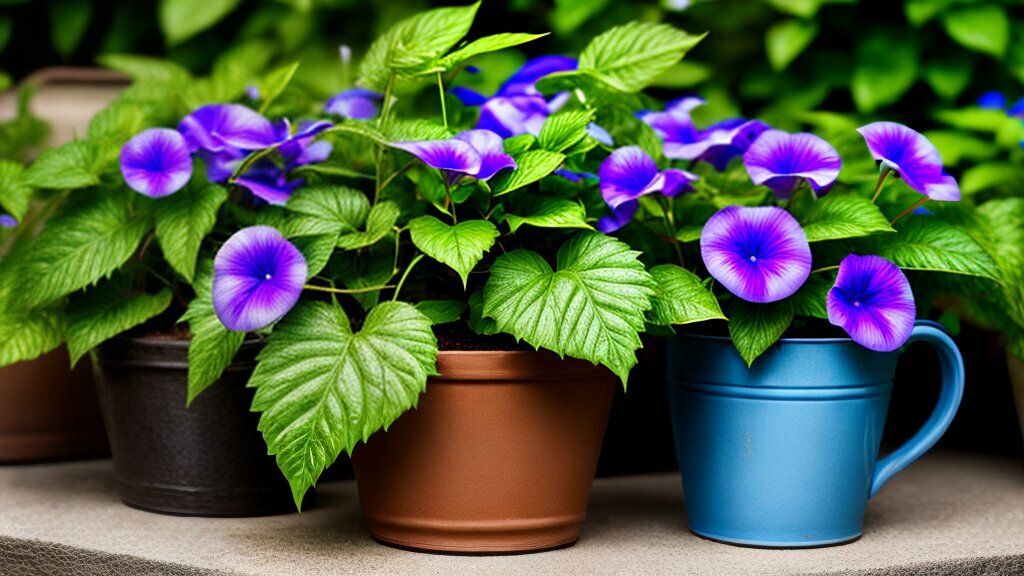
Temperature and Humidity Considerations
Morning glory plants grow best in warm temperatures ranging from 60 to 75°F. Temperatures below 50°F can damage or kill the plant. Depending on where you live, you may need to bring your potted morning glory indoors during cooler months to protect it from the cold.
Morning glory plants love moderate humidity levels. A dry environment can cause the leaves to wilt and the plant to suffer. However, excessive humidity can lead to fungal diseases or mold growth. Keeping a consistent level of humidity in your growing area is key to successful morning glory growth in pots.
If you live in a dry climate, you can maintain humidity levels by misting your morning glory plant with water once or twice a day. Alternatively, you can place a humidifier nearby to keep the air moist. If you live in a humid environment, place a fan near the plant to increase airflow and prevent fungal growth.

Providing Support and Training
One of the most important aspects of growing morning glory in pots is providing adequate support and training for the vines to climb.
Without support, morning glory plants will struggle to grow vertically and may become tangled or droop, reducing their overall health and beauty.
I recommend using a trellis, stakes, or other support structures to provide a stable framework for the vines to climb. Make sure that the support is tall enough to accommodate the full height of the plant, and secure it firmly to the pot.
Training morning glory vines is also an important task. As the plants grow, gently guide the vines to climb the support structure, weaving them in and out of the trellis or stakes. This will encourage vertical growth and prevent tangling or overcrowding.
Be sure to regularly check the vines for any signs of damage or entanglement, and prune any unwanted growth or foliage to keep the plant tidy and healthy.
Providing adequate support and training is key to ensuring healthy growth and abundant blooms for your morning glory plants in pots.
Fertilizing and Pruning
Proper fertilization and pruning are essential to keeping your morning glory plants healthy and vibrant. Fertilizing provides the necessary nutrients to promote growth and blooming, while pruning helps maintain the plant’s shape and encourages bushier growth.
The type and frequency of fertilization will depend on the specific needs of your morning glory plants. A balanced fertilizer with equal parts nitrogen, phosphorus, and potassium can be applied every two weeks during the growing season. It’s important not to over-fertilize, as too much nitrogen can result in excessive foliage growth at the expense of flowers.
When it comes to pruning, it’s best to start early in the plant’s growth cycle. Pinching back the tips of the vines when they are about six inches long will encourage branching and result in a bushier plant. As the plant grows, continue to pinch back the tips to maintain the desired shape and promote lateral growth.
If your morning glory has become unruly or is outgrowing its space, heavier pruning may be necessary. Cut back the plant to about half its size, removing any dead or damaged foliage in the process. This will encourage new growth and help maintain the health and appearance of the plant.
In conclusion, proper fertilization and pruning are crucial components of morning glory care in pots. By providing the right nutrients and maintaining the plant’s shape, you can encourage healthy growth and abundant blooming. Remember to fertilize in moderation and prune regularly to keep your morning glory looking its best.
Dealing with Common Pests and Diseases
While morning glory plants are relatively low-maintenance, they can still fall victim to common pests and diseases. Being aware of these issues and taking action early can help ensure healthy growth and beautiful blooms.
Pests
Aphids, spider mites, and slugs are among the most common pests that can affect morning glory plants in pots. Regularly inspecting the leaves and vines for signs of infestation and taking preventative measures early can save your plants.
To prevent aphids and spider mites, spray your plants with a mixture of water, dish soap, and neem oil. For slugs, try placing copper tape around the base of your pots or using a beer trap to lure them away from your plants.
Diseases
Powdery mildew and leaf spot are two fungal diseases that can affect morning glory plants in pots. To prevent these diseases, avoid overhead watering that can lead to excess moisture on the leaves and provide good air circulation around your plants.
If you do notice signs of disease, promptly remove affected leaves and make sure to dispose of them properly. You may also want to treat your plants with a fungicide to prevent further spread of the disease.
By taking these simple steps to prevent and address pest and disease issues, you can help ensure healthy, vibrant morning glory plants in your pots.
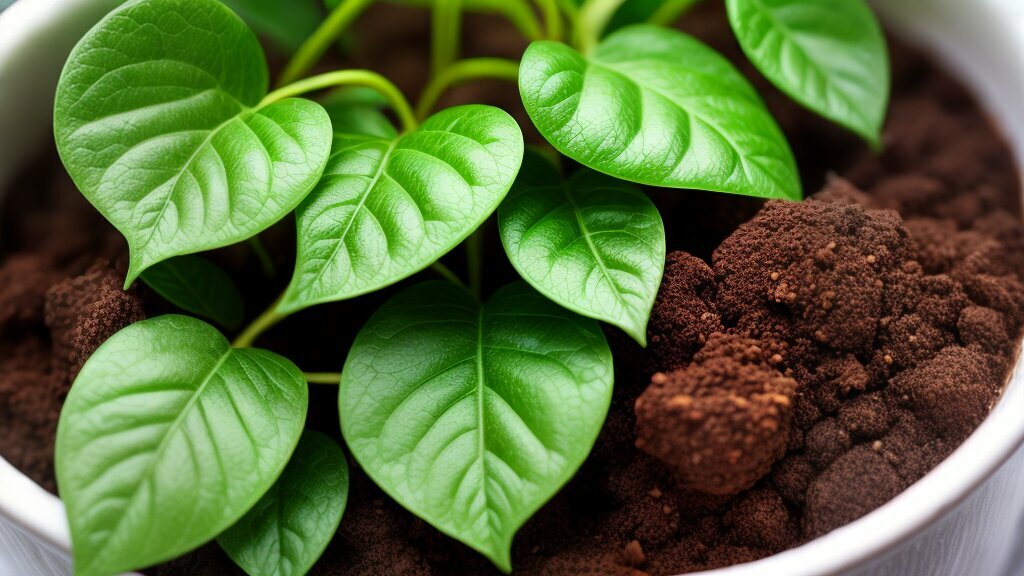
Overwintering Morning Glory in Pots
The process of overwintering morning glory plants in pots is crucial for their survival during the colder months. Here are some tips to help you through this process:
- Prune the plants: Before the first frost hits, prune the morning glory plants to remove any dead or damaged foliage. This will also help to reduce the overall size of the plants and make them easier to store.
- Reduce watering: As the weather cools down, reduce the amount of water you give to your morning glory plants. This will help to prepare them for their dormant period.
- Move indoors: If possible, move your potted morning glory plants indoors to a cool, dark location such as a basement or garage. This will help to protect them from extreme cold and wind during the winter.
- Protect from frost: If you cannot move your plants indoors, cover them with a layer of frost cloth or burlap to protect them from frost damage.
- Store the tubers: If your morning glory plants have formed tubers, carefully dig them up and store them in a cool, dry location for the winter. You can replant them in the spring.
By following these steps, you can help ensure that your morning glory plants survive the winter and thrive again in the spring.

Conclusion
In conclusion, growing morning glory in pots is a rewarding and easy way to add beauty and color to your garden or indoor space. By following the tips and recommendations provided, you can successfully grow and care for these stunning vines in containers. Remember to choose the right container size and material, use the appropriate potting soil, provide adequate sunlight and water, provide support for the vines, fertilize and prune regularly, and protect against pests and diseases. With a little effort and patience, you can enjoy the vibrant blooms of morning glory year after year.
FAQ
Q: How do I choose the right container for growing morning glory in pots?
A: When selecting a container for growing morning glory in pots, consider the ideal size, material, and drainage requirements. Choose a pot that is at least 12 inches in diameter and has drainage holes to ensure proper water flow.
Q: What type of potting soil should I use for morning glory plants in pots?
A: Use a well-draining potting soil mix for morning glory plants in pots. A mixture of equal parts of loam, peat moss, and perlite or sand is recommended.
Q: How much sunlight do morning glory plants in pots need?
A: Morning glory plants in pots thrive in full sun, so they require at least 6 hours of direct sunlight per day for healthy growth and blooming.
Q: How often should I water morning glory plants in pots?
A: Water morning glory plants in pots whenever the top inch of soil feels dry to the touch. Water thoroughly, allowing excess water to drain out of the pot.
Q: What temperature and humidity levels are ideal for morning glory plants in pots?
A: Morning glory plants in pots prefer temperatures between 60°F and 80°F. Maintain moderate humidity levels around the plants to promote healthy growth.
Q: How can I provide support and training for morning glory plants in pots?
A: Provide a trellis, stakes, or other support structures for morning glory plants in pots to allow the vines to climb and grow vertically. Regularly train the vines onto the supports and trim any excessive growth to keep them tidy.
Q: Should I fertilize morning glory plants in pots?
A: Yes, fertilize morning glory plants in pots every 4-6 weeks during the growing season. Use a balanced fertilizer with equal amounts of nitrogen, phosphorus, and potassium to promote healthy growth and abundant blooms.
Q: How do I deal with common pests and diseases on morning glory plants in pots?
A: Prevent common pests like aphids, spider mites, and slugs by regularly inspecting the plants and using organic insecticidal soap or neem oil. Treat common diseases like powdery mildew and leaf spot with natural remedies like a mixture of water and baking soda or a copper-based fungicide.
Q: How can I overwinter morning glory plants in pots?
A: Overwinter morning glory plants in pots by pruning them back, reducing watering, and protecting them from frost. If your morning glory is a tuberous variety, store the dormant tubers in a cool, dry place until spring.
Q: Why should I consider growing morning glory in pots?
A: Growing morning glory in pots allows you to enjoy the beauty and versatility of this vibrant plant even in small spaces. Container gardening with morning glory can add color and a touch of nature to your patio, balcony, or windowsill.
 Little Garden Tips
Little Garden Tips






